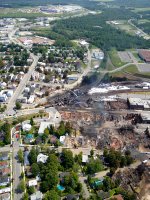Scooby074
Super Member
Here's one thing that Ive been wondering.
The trains air brakes were set, but considering the train was to be left unattended for several hours why wernt the hand brakes on several cars applied as well?
Why wernt derailers used on the downhill side? How long to they take to apply? Can they be applied by a single man without tools, or do they require a work crew?
From one article I read, it sounds like train brakes are air applied, spring release. Apparently one engine was left running to supply air. That engine was shut off. Not good. Certainly not how I would have designed them. And another strange thing from the article, the last person from the company at the train was a maintenance man, not the engineer.
The trains air brakes were set, but considering the train was to be left unattended for several hours why wernt the hand brakes on several cars applied as well?
Why wernt derailers used on the downhill side? How long to they take to apply? Can they be applied by a single man without tools, or do they require a work crew?
From one article I read, it sounds like train brakes are air applied, spring release. Apparently one engine was left running to supply air. That engine was shut off. Not good. Certainly not how I would have designed them. And another strange thing from the article, the last person from the company at the train was a maintenance man, not the engineer.

